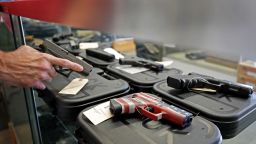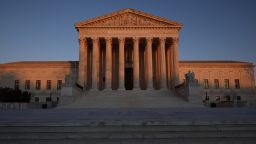It did not take long for top gun rights activists to realize that the Second Amendment ruling handed down by the Supreme Court in June was going to transform the legal fight over access to firearms.
Dudley Brown, the president of the National Association for Gun Rights, said the realization started to come when he received a phone call from another executive at his organization minutes after the decision was released.
“He had just scanned through it. He said, ‘You won’t believe what this decision says. it’s way better than what we ever hoped for,’” Brown told CNN. Brown was coincidentally at the time walking by the Supreme Court, trekking between Senate and House offices as part of a lobbying push against new gun legislation being considered in the wake a mass shooting at an elementary school in Uvalde, Texas.
“Quickly, we knew this was something that was going to change the landscape,” Brown said.
In the three months since the 6-3 decision in New York State Rifle & Pistol Association, Inc. v. Bruen, scores of new lawsuits have been filed against gun restrictions at the federal, state and local levels.
Though the Supreme Court case concerned a type of gun permitting regime embraced by just a handful of states, the conservative majority used the Bruen decision to provide new instructions for how courts are to assess the constitutionality of gun laws nationwide.
The decision was the first major Supreme Court guns ruling in more than a decade, and it came after Justice Clarence Thomas – who authored the majority opinion – had previously complained that the high court had allowed the Second Amendment to be treated as a “a disfavored right.”
Since the June ruling, federal judges in at least a half-dozen different cases have already cited the Bruen decision to rule against gun restrictions that have included local assault weapons bans, prohibitions on the manufacture of homemade firearms and bans on older teenagers publicly carrying handguns.
Several other laws now face new legal challenges under the precedent, among them zoning restrictions barring shooting ranges, licensing and training laws and the federal ban on certain misdemeanor offenders from possessing firearms.
“The much more consequential thing about Bruen is that the court actually went further and did a little bit more than it needed to do and articulated an entirely new framework for how Second Amendment challenges are decided,” said Andrew Willinger, the executive director of Duke Center for Firearms Law.
What the Supreme Court told judges to do
The case the Supreme Court decided last term was a challenge to the New York state system of approving licenses for gun owners to publicly carry their weapons. By a 6-3 vote, the justices said the rules – in which government officials had some discretion in deciding whether an applicant would be granted a license – violated the Second Amendment.
But what extended the reach of the ruling beyond the roughly half dozen states with similar licensing procedures was what Thomas said about how courts should decide whether gun limits comply with the Second Amendment.
Thomas said that the only regulations that can be deemed constitutional are ones don’t encroach on conduct plainly covered by the Second Amendment’s text and that are “consistent with this Nation’s historical tradition” – meaning they have a parallel in the type of regulations in place at the time of the Constitution’s framing.
Justice Stephen Breyer, writing for the three liberal dissenters, wrote that this approach was “deeply impractical” and that it imposed “a task on the lower courts that judges cannot easily accomplish.”
Before the Supreme Court’s ruling, lower courts were coalescing around an approach that weighed the burden a restriction put on gun rights against the rationale the government had for implementing the law. The flurry of litigation spawned by the new precedent has begun to show how much the Bruen test will remake the legal playing field around firearms.
A federal district judge cited the ruling last month when halting Delaware restrictions on possessing and manufacturing untraceable firearms, saying that the law’s defenders failed to provide persuasive evidence that similar restrictions existed in the historical record. The precedent was also referenced when local assault weapon bans in two Colorado jurisdictions were put on hold this summer; the judges in both cases were each appointed by Democratic presidents.
On Thursday, a federal judge in Syracuse leaned on Bruen to pause several New York restrictions, including limits on carrying firearms to sensitive places like summer camps, domestic violence shelters and zoos.
Laws that withstood legal challenge in the past are now in jeopardy.
Texas’ public carry handgun ban for 18- to 20-year-olds – a ban that was upheld by the conservative 5th US Circuit Court of Appeals in 2012 – was struck down by a district court last month. US District Judge Mark Pittman wrote in the opinion that he had not been pointed to any Founding-era laws that were a “sufficient historical analog to support Texas’s statutory prohibition.”
Gun safety advocates say there are cases where the historical record will be on their side, and, at least in the early post-Bruen flurry of legal action, some laws have been successfully defended in court.
A judge who declined to block a San Jose, California, law requiring liability insurance for gun owners said that the mandate had adequate parallels in 19th century surety laws, which required some individuals to post bond in order to carry weapons. A week after a federal judge in Texas ruled against a federal law banning those under felony indictment from buying, the same judge decided in favor of the prohibitions on convicted felons possessing firearms. US District Judge David Counts reasoned in the latter case that there was a historical tradition supporting the exclusion from the Second Amendment’s protections people who “squander their rights for crimes and violence.”
“If the question is now whether there’s a tradition of regulating firearms in different respects, we think that the historical evidence is going to show the answer is yes,” said Eric Tirschwell, the executive director of Everytown Law, which is the litigation arm of the advocacy group Everytown for Gun Safety.
Changing the work advocates must do to defend restrictions
The Bruen ruling, when laying out the historical prong of the test, said it was up to the government that was defending a gun law to prove the restriction had a parallel in the past.
This shift in burden has put gun rights groups at a greater advantage in court. It has also changed the type of work that government defenders – and the outside gun safety groups that often support them in litigation – must do to advocate for their laws.
“Imagine if you are a district attorney, somewhere in some random state, you suddenly get a lawsuit brought on this, on some gun law you’ve got, and then you’ve got maybe 30 days to respond to the lawsuit. What are you going to do?” said Carlton Larson, a professor at UC-Davis School of Law who specializes in the historical basis of Second Amendment rights.
“I am a legal historian by training,” Larson said. “I would find it very, very hard to turn around quickly on that and come up with something thoughtful.”
But gun rights advocates say this work of historical analysis is a better fit for courts than the means-ends balancing test that many lower courts were applying pre-Bruen. The old approach required courts to act like legislators, said Peter Patterson – a lawyer for the firm Cooper and Kirk, which has represented gun rights groups in high profile cases – while the historical analysis, he said, is “much more a judicial task.”
The Bruen decision has also put a greater focus on the first prong of the legal test – whether the conduct being burden is even covered by the Second Amendment in the first place – which was a question that was “underappreciated” in litigation over gun laws in the past, according to Tirschwell.
Unanswered legal questions courts will hash out
As lower courts begin to apply the new precedent, questions left open by the Bruen ruling will be hashed out and debated.
While finding laws in the historical record may be “clear cut,” according to David Kopel, an adjunct scholar at the libertarian Cato Institute, “there’s still room for judicial discretion” in deciphering how closely a contemporary law must mimic its historical counterpart to be upheld.
“Bruen says: You can have a modern gun law, that it doesn’t have to be a twin of some historic law. You can reason by analogy,” Kopel said.
US District Judge Glenn Suddaby, the judge who blocked parts of a New York gun law Thursday, said the historical parallels were strong enough for him to let stand the state’s ban on carrying firearms into schools.
“However, the Court cannot find these historical statutes analogous to a prohibition on ‘summer camps,’” he wrote, so he was halting the ban on carrying firearms there.
One question legal experts will be watching is what Bruen means for the types of gun laws that the Supreme Court had previously identified as “presumptively lawful” in the landmark 2008 Heller case establishing that individuals have a right to bear arms. In the majority opinion, Justice Antonin Scalia wrote that the ruling was not meant to cast doubt on restrictions on carrying guns in sensitive places, possession bans for the mentally ill or felons, or other certain conditions imposed on the purchase of firearms.
“It seems to be those that those Heller exceptions are up for grabs, potentially,” Larson said, referring to the name of the 2008 case.
Another question raised by the Bruen decision is what should be the historical touchpoint for assessing whether a restriction is constitutional: the 1791 enshrining of the Bill of Rights or the 1868 ratification of the 14th Amendment, under which the court has extended the protections against federal infringements on gun rights to state and local governments.
Gun advocates are staking out their arguments for seeing the earlier time period as the relevant one for whether a contemporary gun law has a historical analogue.
“It’s really difficult for me to see guideposts in what the court said in Bruen,” Willinger said. “It really does leave quite a bit up to the judge in terms of determining what level of generality do I use to look at the history.”
CORRECTION: This story has been updated to correctly spell David Kopel’s name.


